Pier Trains
The First Railway
The
first
Pier
railway
was
on
the
wooden
pier,
opening
around
1846.
These
were
hand
propelled
carts
running
on
a
single
wooden
track,
on
windy
days,
a
cart
with
a
sail
would
be
used, this railway was used until 1873.
Horse Drawn Railway
When
the
local
board
took
over
took
over
the
wooden
pier
they
replaced
the
hand
propelled
carts
and
the
timber
rails
to
iron,
this
new
train
was
little
more
than
three
box
like
wagons
and
a
flat
carriage
at
the
rear,
two
horses
hauled
the
train
the
length
of
the
pier.
The
service
started
in
1873,
by
the
1880s
the
track
had
become
unsafe,
the
horses
kept
putting
their
hooves through holes/gaps in the decking and the service stopped.
The Toast Racks
The
Toast
Racks
came
along
when
new
Iron
Pier
was
built,
this
at
first
was
constructed
alongside
the
closed
wooden
pier.
The
plan
for
the
new
pier
included
the
worlds
first
electric
railway,
work
was
overseen
by
Mr.
C.
R.
Norton,
the
former
Electrical
Engineer
of
the
pier,
electrification
was
carried
out
by
Colonel
R.
E.
B.
Crompton.
By
1889
¾
mile
of
track
had
been
laid
on
the
new
pier
with
a
single
motor
car
running
on
it.
This
had
a
13
hp
motor
powered
from
a
200v
DC
generator
sited
on
the
pier.
The
Generator
was
compound
wound
driven
by
a
belt
connected
to
a
Davey
&
Paxman
25
hp
steam
engine,
using
a
locomotive
style
boiler.
The
electric
car
was
fitted
with
a
carbon
brush
which
picked
up
power
from
a
centre
rail
mounted
on
petticoat
insulators, the return circuit was through the running rails.
By
1890
the
first
stage
of
the
then
1¼
mile
track
was
complete
with
two
new
trailer
cars
in
operation.
Passengers
numbers
were
increasing,
so
alterations
to
the
track
were
made
and
a
passing
loop
was
installed
in
1893,
also
a
new
train
of
three
coaches
were
added
to
the
fleet.
These
were
built
by
Falcon
works
in
Loughborough.
From
1893
through
to
1899
passenger
numbers
increased
again,
to
such
a
level
that
a
further
two
trains
were
purchased,
a
second
generator
was
installed
as
well
further
alterations
to
the
track,
and
the
passing
loop
was
extended.
In
1902
Southend
Council
built
a
dedicated
generating
station
in
London
Road,
making
the
pier-based
station
redundant,
which
later
was
demolished.
The
new
power
station
was
capable
of
producing
500v
DC,
this
saw
the
trains
re-fitted
with
new
engines
rated
at
18
hp,
with this increased power, four more coaches were added to the fleet, this enabled four trains of up to four coaches.
In
1909
four
more
coaches
were
added
to
the
fleet,
this
saw
each
of
the
four
trains
in
operation
travelling
with
five
coaches.
However,
the
extra
weight
of
cars
&
passengers
proved
that
the
motor
cars
were
underpowered
and
had
to
be
up
graded
again,
this
time
twin
BTH
27
hp
motors
were
fitted.
During
1910
the
ageing
conductor
rail
was
replaced
with
a
45lb/yard
steel
rail,
much
like
the
running
rails,
this
also
saw
the
pick
ups
being
replaced
with
cast
iron
ones.
1914
saw
a
further
eight
cars
added
allowing
four
seven
car
trains.
In
1919
a
survey
of
the
track
found
that
it
was
in
a
poor
condition
so
a
track
renewal
program
was
launched,
this
saw
the
now
20
year
old
lines
replaced
by
steel.
In
1923
a
short-lived
experiment
saw
magnetic
breaks
fitted
to
one
train,
with
poor
results the test was abandoned in 1924. During the year the trains running wheels were all replaced with Bessemer Steel Tyres.
During
1928
the
midway
passing
loop
was
extended
again
this
time
by
150
yards,
two
further
loops
were
added
at
both
the
North
station
(Shore)
and
the
South
station
(Head).
The
following
year
in
1929
saw
the
loops
all
joined
forming
a
double
track
the
length
of
the
pier.
To
keep
the
trains
in
running
order
a
workshop
was
constructed
on
the
west
side
of
the
shore station.
Wartime
saw
the
pier
trains
pushed
into
service
carrying
over
300,000
troops,
at
the
end
of
hostilities
the
holiday
makers
returned,
by
1949
the
now
60
year
old
Toast
Rack
trains
were
beginning
to
become
more
difficult
to
maintain,
a
decision
was
made
to
replace
the
entire
rolling
stock
with
new
trains.
During
their
lifetime
the
toast
racks
had
clocked
up
some
three
million miles, carrying some sixty five million passengers.
Toast Rack Specifications
Dimensions:
Length:
22ft
9in
to
24ft
(different
types
of
car
having
varying
lengths).
Height:
6ft
11in
to
7ft
3in
(different
types
of
car
having
varying
height).
Width:
6ft
5in.
Wheelbase:
6ft
9in
to
11ft
6in
(different
types
of
car
having
varying
lengths).
Seats:
32,
36,
40
(various seating in differing cars). Motors: General Electric GE60-4t 2 x 27hp. Controllers: General Electric GE K10.

Southend Timeline Southend-on-Sea © 2009 - 2024. All Rights Reserved

Southend-on-Sea
Severn-Lamb Trains
Trains
were
to
returned
to
the
pier
in
1986
when
two
Severn-Lamb
trains
were
installed,
the
trains
numbered
A
&
B
are
named
Sir
John
Betjeman
&
Sir
William
Heygate,
these
operate
on
a
3’
gauge
track
laid
on
conventional
cross
sleepers,
a
single
track
with
passing
loop
based
on
the
1893
layout
is
used
with
atomised
signalling.
The
trains
are
operated
as
a
CT-T-T-T-T-T-PC
set.
The
two
trains
were
originally
presented
in a "inferno red" but after the pier head fire of 2005 both trains were re-painted blue.
Severn Lamb Trains Specifications
Power
Cars
(PC):
Length:
20ft
9in.
Weight:
4
tons.
Seats:
0
(except
for
driver).
Engine:
Deutz
4
cylinder
55
hp
diesel,
two
Linde
hydraulic
transmission
chain
&
sprocket
to
each axle. Max Speed: 18 mph.
Trailer (T): Length: 20ft. Weight: 2 tons. Capacity: 24 seated 10 standing.
Control Trailer (CT): Length: 20ft 9in. Weight: 2 tons. Capacity: 12 seated plus clear area for wheel chairs.
All Cars: Width: 5ft 9in, Height: 7ft 6in.
Castleline Train
A
low
peak
winter
operating
train
is
available
for
use
on
the
railway.
This
is
a
single
unit
battery
car
built
by
Castleline
of
Nottingham.
It
is
a
three
axle
double
ended
car
that
has
doors
in
the
centre
of
the
body.
The
train
is
marked
as
“1835”
which
represents
the
date
that
the
pier
first
appeared on Admiralty charts.
Castleline Train Specifications
Not currently available
Pier Trains in Preservation
So just what remains of the fleet.
The Toast Racks
There
were
originally
28
"toast
rack"
pier
trains
operated
on
the
pier,
today
just
three
are
known
to
be
preserved,
however,
who
knows what might pop up in the years to come.
The Survivors
No
6:
The
Southend
Pier
Museum
hold
one
original
Toast
rack
train
from
the
1889
it
was
recovered
in
poor
condition
&
has
been
restored to original stock condition.
No
8:
Was
donated
to
the
Southend
Pier
Museum
by
the
Brighton
based
Volks
Railway
in
2001,
but
due
to
lack
of
space
within
the
museum
it
was
exhibited
on
the
deck
of
the
pier,
it
was
later
offered
to
The
Standford
Mill
Museum
but
due
to
lack
of
space
it
was
not
taken up and moved into store.
No 9: In storage with the Volks Railway Brighton.
1949 Rolling Stock
There
were
originally
28
cars
built
to
replace
the
Toast
Racks,
half
the
fleet
were
retired
and
scrapped,
with
the
remaining
14
continuing
in
service
until
the
closure
of
the
railway,
most
of
these
went
to
a
scrap
yard
in
Shoebury,
a
few
were
saved
and
were
preserved,
three
ended
up
going
to
Wales
these
being
nos
2,
7
&
21.
Over
the
years
car
21
was
returned
to
Southend,
whilst
it
is
rumoured
car
7
returned
to
Southend
in 2001 and is currently in store. Car 2 was scrapped in Wales.
The Survivors
Car 7: Returned to Southend 2001 stored in secure location not available to public inspection.
Car 8: Mangapps Railway Museum in Essex.
Car 11: The Southend Pier Museum.
Car 21: The Lynn Tate Gallery, Leigh-on-Sea, (Now Closed).
It's not Just Trains...!
In
1972
Mitchell
Ropeways
propose
to
replace
the
train
with
the
Swiss
designed
Aerobus
suspended
monorail.
The
proposal
would
have
seen
pylons
placed
alongside
the
pier
linked
by
a
steel
cable,
two
100
seater
“Aerobuses”
would
have
been
hung
from
the
cable
like
a
cable
car.
The
area
where
the
track
had
been
set
would
have
been
turned
into
a
widened
walkway.
The
scheme
never
materialised.
In
2001
the
cable
car
proposal
returned,
this
would
have
seen
the
traditional
Pier
trains
and
track
removed,
with
the
area
becoming
part
of
the
walkway,
the
trains
would
be
replaced
by
cable-cars
or
a
monorail
linking
the
Pier
head
with
the
shore
station,
the
cost
was
put
at
over
£10million,
which
only
a
company
from
the
private
sector
would
be
able
to
fund.
The
scheme
again
never
materialised.
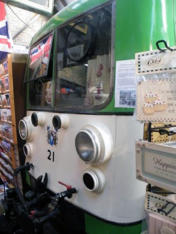

The AC Cars
AC
Cars
Ltd
of
Thames
Ditton
were
chosen
to
built
the
new
fleet
of
28
cars
to
form
four
trains
of
seven
cars,
these
trains
had
three
powered
cars
(M)
and
four
trailer (T) cars. These were run as a M-T-T-M-T-T-M set up.
The
operating
service
saw
a:
peak
time
service,
with
all
four
trains
in
operation,
whilst
one
was
moving
in
each
direction
the
other
two
would
be
waiting
at
either
station
for
the
approaching
train
to
enter
the
station
where
it
would
depart,
the
theory
behind
the
plan
was
that
if
a
passenger
walked
on
to
the
platform
there
would
on
most
occasions
be
a
train
waiting.
Off
peak
service,
two
trains
running
with
the
other
two
in
stations
out
of
use.
Low
season
service,
one
train shuttle service, one train in each station the other on the track.
By
the
1970s
two
of
the
trains
had
been
permanently
withdrawn
from
use,
only
cars
1-7
and
22-28
remaining.
One
of
the
retired
power
cars
was
transformed
into
a
works
loco,
the
body
shell
was
removed
leaving
only
the
drivers
cab,
a
flat
platform
was
built
over
the chassis which provided a means of transporting goods out to the pier head.
The
East
line
(sea-side)
was
originally
used
as
the
up
(to
pier
head)
line
with
the
west
(walkway)
as
the
down
(to
shore),
this
enabled
conventional
left
hand
drive
cars.
The
trains
crossed
by
the
scissors
crossovers
situated
approximately
400
yards
from
each
station.
By
the
mid
1970s
the
operation
had
changed
to
both
trains
using
the
east
platform
at
the
north
station
running
over
the
east
track
to
the
second
crossover
located
at
the
first
signal
box,
at
which
point
alternate
trains
were
switched
to
the
west
track,
at
the
south
station
both
sides
were
still
used.
So
that
people
would
not
get
confused
as
to
which
train
would
be
the
next
to
depart
from
south
station
the
service
was
scheduled
so
that
at
no
time
were
the
two
trains
in
the
station
at
the
same
time.
Departing
trains
moved
out
of
the
station
to
a
signal
protecting
the
cross
over
where
it
waited
for
the
southbound
train
to
pass.
The
west
track
between
the
two
crossovers was not used and the west platform at the north station was used for the works unit.
The
AC
trains
remained
in
service
until
the
October
1978
when
an
inspection
of
the
track
found
it
had
deteriorated
to
a
state
where
it
needed
completely
replacing,
it
was
condemned
and
the
trains
and
work
unit
were
permanently
withdrawn
from
use.
In
1976
the
pier
head
suffered
a
devastating
blaze,
which
saw
98%
of
the
facilities
destroyed,
with
an
ever-increasing
maintenance
budget
the
council
took
the
drastic
action
and
closed
the
pier.
When
it
finally
re-opened
the
railway
was
not
operational
and
only
a
few
limited
facilities
were
open
on
the
pier
head.
The
trains
were
sold
off,
four
cars
went
to
Tal-y-cafn
in
Wales,
the
rest
of
the
rolling
stock
went
to
a
scrap
yard
in
Shoebury.
During
the
29
years
in
service
the
AC
cars
had
travelled
many
millions
of
miles
carrying
some
forty
five
million passengers.
A. C. Cars Specifications
Power Cars
Weight
of
motor
car
(un-laden):
5
tons
15
cwt
5842
kg.
Weight
of
trailer
car:
4
tons
4
cwt
4267
kg.
Number
of
passengers:
38.
Length
over
buffers:
29ft
6in,
9m.
Height
from
rail-level:
7ft
9in,
2m
36.
Overall
width:
6ft
6in,
1m
98.
Wheelbase:
14ft
6in,
4m
42.
Wheel
diameter:
24",
60cm.
Traction
Motor
rating:
17
hp
12.6
kW.
Transmission
Gear
ratio:
57/8
7.125:1.
Maximum
acceleration:
1
mph/sec,
1.60kph/sec.
Maximum
braking
rate:
1½
mph/sec,
2.41
kph/sec.
Maximum
speed:
18
mph,
29
kph.
Motors:
Crompton
Parkinson CP 30 2 x 17hp. Controllers: Allen West. Motor Car No’s: 1, 4, 7, 8, 11, 14, 15, 18, 21, 22, 25, 28.
Trailer
Car:
Weight:
4
tons
14
cwt.
Seats:
34.
Length:
29ft
6in.
Height:
7ft
9in.
Width:
6ft
6in.
Wheelbase:
14ft
6in.
Wheel
Diameter:
2ft. Trailer Car No’s: 2, 3, 5, 6, 9, 10, 12, 13, 16, 17, 19, 20, 23, 24, 26, 27.
Car No 21 Lynn Tait Gallery
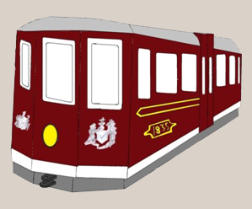
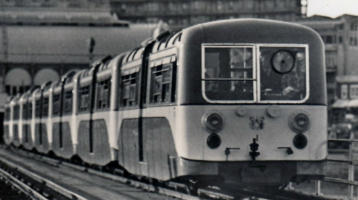
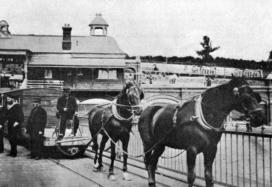
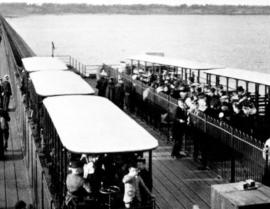
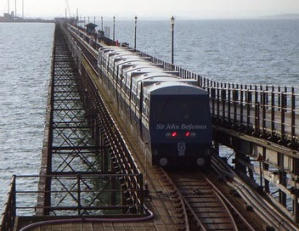
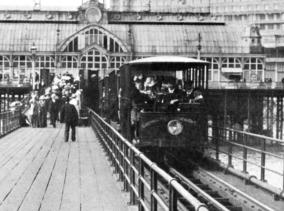
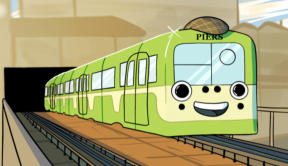
2nd May 1986: Inauguration of New Pier Train Service
10:15am:
Her
Royal
Highness
Princess
Anne
will
arrive
by
Helicopter
at
Priory
Park,
Victoria
Avenue,
Southend-on-Sea.
On
alighting
from
the
helicopter
her
Royal
Highness
will
be
received
by
Her
Majesty’s
Lord
Lieutenant
for
Essex
Admiral
Sir
Andrew
Lewis
KCB.
Her
Royal
Highness
will
proceed
to
waiting
cars
for
the
journey
to
Nazareth
House,
London
Road,
Southend-on-Sea, via Victoria Avenue, Victoria Circus and London Road.
10:30am: Her Royal Highness will open the reconstructed West Wing of Nazareth House.
11:30am:
Her
Royal
Highness
will
leave
Nazareth
House
for
the
journey
to
Southend
Pier,
the
route will be London Road, Queensway, Southchurch Avenue and Marine Parade.
11:40am:
Her
Royal
Highness
will
arrive
at
the
marine
Parade
entrance
to
the
Pier
where
she
will
be
received
by
the
Mayor
and
Mayoress
of
Southend-on-Sea
Councillor
P.
H.
Herbert
and
Mrs J. Herbert.
His Worship the Mayor will present:
Councillor N. Clarke Leader of Southend-on-Sea Borough Council and Mrs Clarke.
Councillor Mrs. L Collard Deputy Mayor and Mr Collard.
Councillor G. Littler Chairman of the Leisure Services Committee and Mrs Litter.
Councillor N. Moss Chairman of the Property and Development Committee and Mrs Moss
Councillor D. Garston Chairman of the Environmental Services Committee and Mrs Garston.
Miss Lucy Payne will present Her Majesty with a posy.
Her Royal Highness will be conducted by the Mayor and Mayoress to the North station platform.
Councillor N. Clarke will then invite Her Royal Highness to name one of the trains the “Sir John Betjeman”
11:50am: The Royal party will board the front two carriages of the train for the journey to the South Station at the Pier head.
12:00 noon: On arrival at the South Station the Mayor will invite her Royal Highness to unveil a plaque commemorating her visit.
12:02pm:
The
Royal
party
will
then
move
to
the
Lifeboat
station
where
the
mayor
will
formally
hand
over
a
new
lifeboat
to
the
Royal
National Lifeboat Institution. After a short service of dedication Her Royal Highness will name the new boat the “Percy Garon 2”.
12:20pm:
The
Royal
party
will
then
proceed
to
the
South
Station
via
a
marquee
in
which
there
will
be
a
small
exhibition
showing
the
intended development of the pier.
12:25pm: The Royal party will board the first two coaches of the train and return to the North Station.
12:40pm:
The
Royal
Party
will
leave
the
North
Station
at
marine
Parade
level
and
enter
the
cars
for
the
journey
to
Porters.
The
Route
will be Marine Parade, Southchurch Avenue, Queensway, Southchurch Road and Tyrrel Drive.
12:45pm: The Royal party will arrive at Porters where were Royal Highness will take lunch.
2:30pm
The
Mayor
and
Mayoress
will
conduct
Her
Royal
Highness
to
the
waiting
cars
to
take
their
leave.
Her
Royal
Highness
will
enter the Royal Car for the journey to Abbeyfield Archer House, Laindon Road, Billericay.
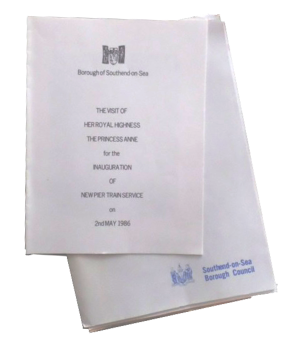

Southend-on-Sea’s No 1 History Website! Documenting The Town & The Townspeople

Now Incorporating The Sea Of Change Website
Website Info:


Chalkwell ▪ Eastwood ▪ Leigh-on-Sea ▪ Prittlewell ▪ Shoeburyness ▪ Southchurch ▪ Thorpe Bay ▪ Westcliff-on-Sea
SOUTHEND CITY
































































